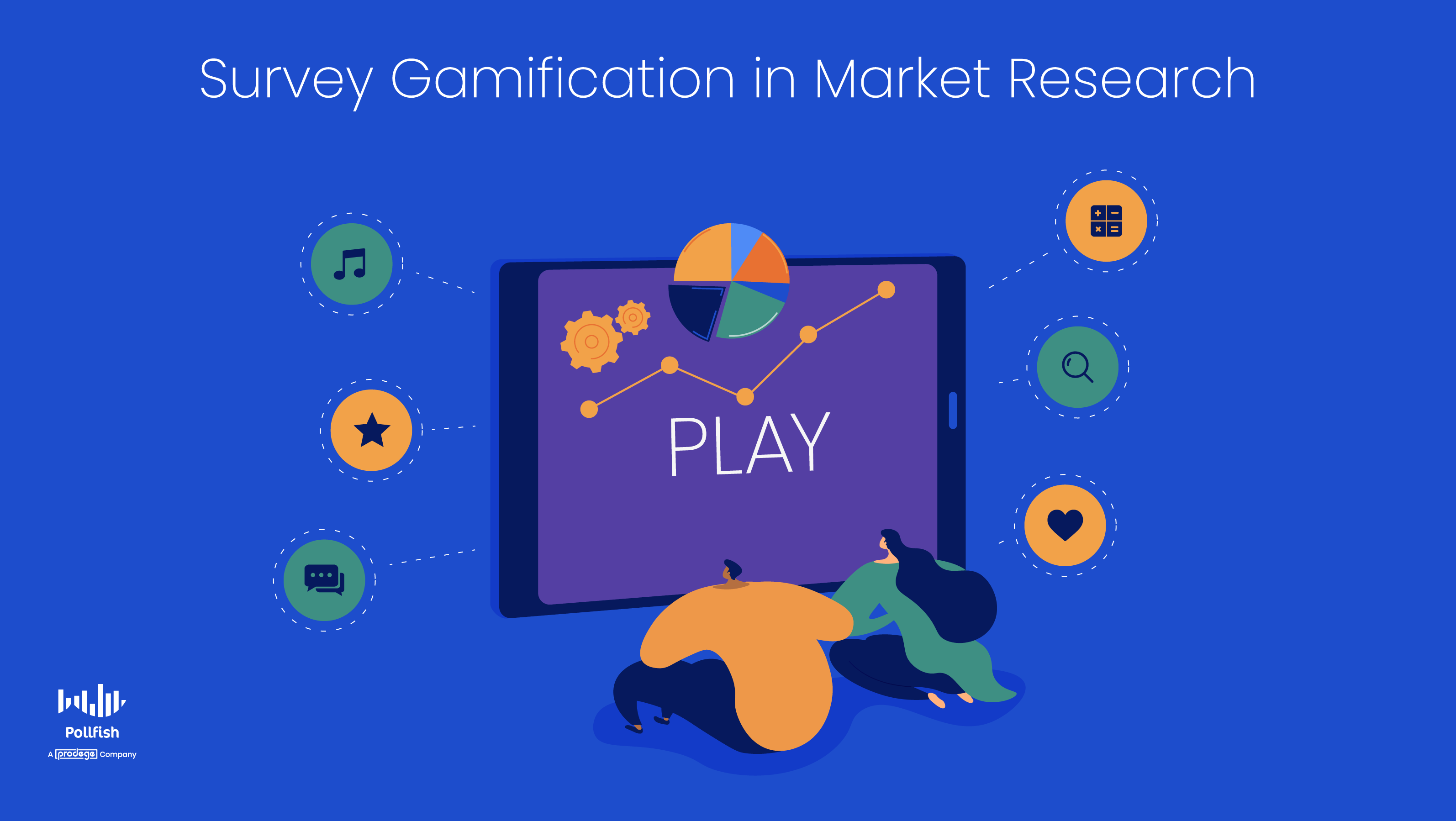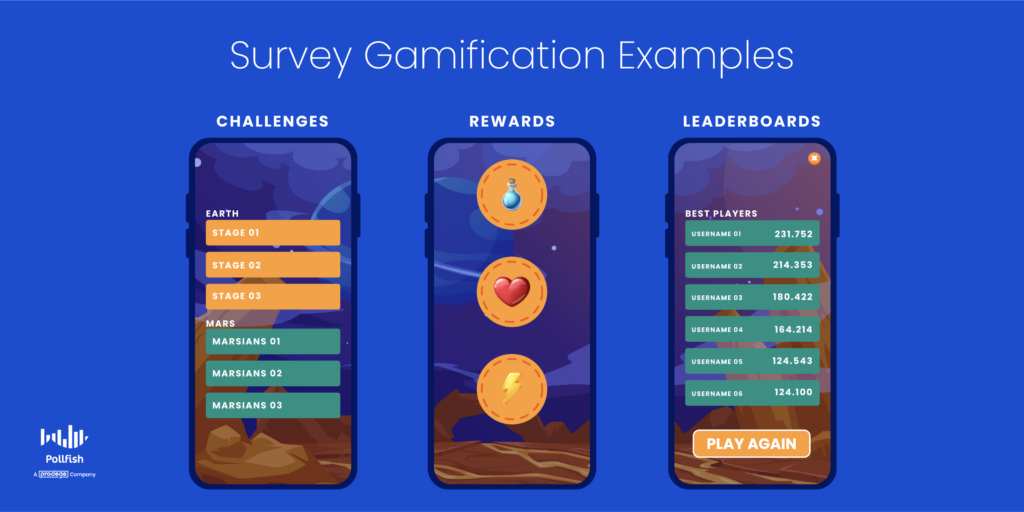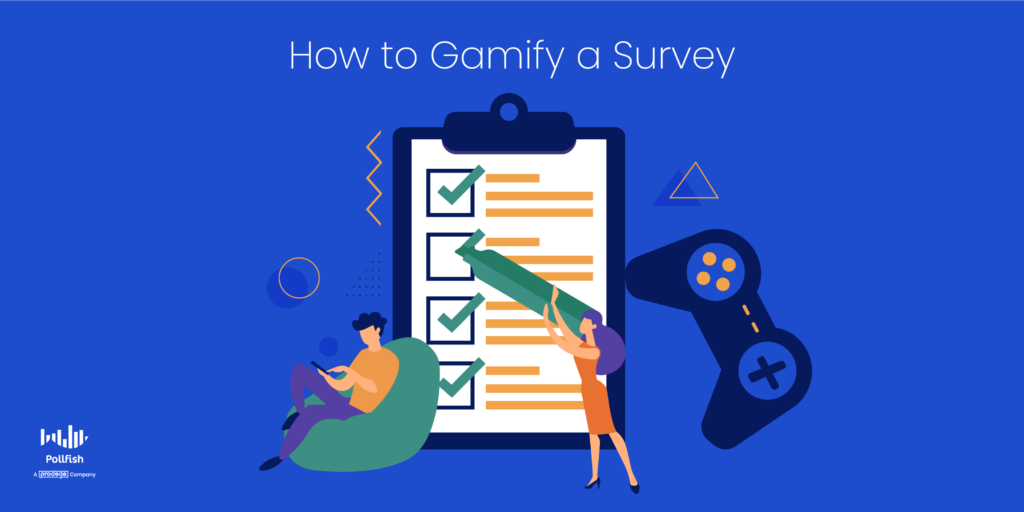Gamifying Market Research with Survey Gamification

Survey gamification is one of the most effective ways to enhance the survey experience and increase your survey completion rate — and for good reason, as gamification is a hot topic, with a global market projected to grow from $9.1 billion in 2020 to $30.7 billion by 2025.
Gamification is being applied across a wide range of industries, from education, to HR, to retail and banking. In fact, a Texas bank raised customer acquisition by 700% via gamification. The clothing company Moosejaw implemented a gamified system, which increased sales by 76%.
Given the unmistakable advantages of gamification and the shift from traditional market research to online mobile surveys, it is inevitable that gamification will become coupled with survey research. Many businesses are already adopting this hybrid approach, as should yours to stay competitive.
This article examines survey gamification, including its key examples, utilities, importance and how to establish it in your surveys to augment your market research techniques.
Understanding Survey Gamification
Survey gamification takes the premise of gamification and implements it for market research purposes, in turn creating what is apt to call a gamification survey.
First, it’s key to understand the precise meaning behind gamification before applying it to surveys. Gamification refers to the integration of game mechanics into non-game contexts, such as websites, online communities, SaaS products such as learning management systems, other systems, activities and services.
The aim of gamification is to forge similar experiences to those of playing games in non-leisure environments to motivate and engage users. In today’s competitive business world, it didn’t take long for gamification to make its way into the business sphere.
Gamification can be applied to various business practices to engage customers, employees, partners and various other stakeholders. When it comes to market research, researchers can apply this practice and create a gamification survey.
Survey gamification is the practice of using gaming elements and techniques in surveys. This method enhances the survey experience, fostering participation and engagement, which supports respondents completing a survey, as there is no element of boredom.
The goal of survey gamification is to create surveys that are more interactive, engaging, and enjoyable during participation. This enables them to better engage with consumers, employees, partners and all other survey participants.
Examples of Survey Gamification
There are several ways to gamify a survey; this can mean only using a few game elements, or even only one. The following lists some examples of prominent elements and techniques to use for a gamification survey:

- Leaderboards
- This provides an element of personalization as respondents can see their names and the display of their performance levels.
- This also provides the game element of competition, as respondents will be motivated to score higher, which can have different applications in different surveys.
- This will motivate the respondents to finish their survey, provide quality feedback and do whatever else you demand, as they’ll want to score higher to earn a reward.
- Rewards
- Rewards are also known as survey incentives. They can be monetary or non-monetary.
- The reward should correlate with the time and effort that respondents invested.
- High-tier and pricey rewards should be in surveys that mention your brand, as this is key for brand awareness. This tactic will remind respondents of your business and establish a positive brand experience.
- Badges
- This is a kind of reward itself that shows respondents’ level of achievement.
- This can be applied in-survey, or if you use an online survey platform that partners with a mobile game, this badge can be rewarded through the game itself.
- The respondents should receive a badge, at the end of the survey.
- Or, they should receive some points or anything that can then be conveyed through a ranking system.
- A Progress Bar
- This shows respondents how close they are to completing their survey.
- This is far more interesting than a plain survey that gives no visual or other kinds of indication of how far respondents are in the survey.
- This also provides a higher level of transparency, which will motivate respondents to finish the survey, as they won’t be left wondering how much longer they have to go.
- Avatars
- Here, you can allow respondents to create their own avatars for answering your questions.
- Allow your respondents to save these as unique images they can use elsewhere.
- Additionally, the answers to questions themselves can be avatars. This way, rather than expressing themselves in words, your respondents can choose an avatar that reflects their answer.
- Through this element, you’ll have your answers while the respondents get a pleasant survey experience.
- Virtual currencies
- This can be cryptocurrency or survey currency unique to your brand.
- For example, you can provide “currency” that virtually acts as a gift card to your company.
- You can also provide currency to a desktop or in-app game, should the online survey platform you use to deploy your survey to gaming sites and apps.
- Challenges for your respondents
- Include visual and other gaming challenges in your survey, such as solving a puzzle.
- Aside from being engaging, this will show you if your respondents are paying attention.
- You can get creative here, the more interesting you make your challenges, the better it is for your brand visibility.
The Importance of Survey Gamification
The days of dull surveys that left respondents feeling as though they’ve completed a chore are in the past. With survey gamification, your surveys will keep your users engaged throughout the survey.
With this key benefit in mind, you should also understand that a gamification survey has far more importance than merely offering the element of fun into a survey.
Due to gamification, the respondents are more motivated to complete the survey. As such, they are more likely to provide quality answers. This is a major benefit for market researchers, as it results in higher quality data for analysis.
Survey gamification also draws more interest in partaking in a survey to begin with, which increases your survey response rates. In addition, aside from partaking in the survey, survey gamification cuts back on boredom and maintains higher levels of engagement, which in turn, increases the survey completion rate.
When respondents are deeply engaged, they won’t feel bored or discouraged from finishing their survey. As such, a gamification survey plays a major role in reducing survey attrition.
The gamification of surveys is also important, in that games gratify the basic human need of self-fulfillment. Their motivational factor occurs owing to this need. Games also generate the effect of being fully immersed and involved in an activity.
Gamified surveys also feed into the respondents’ sense of developmental growth and accomplishment, which adds to their user experience.
These are the key aspects that all UX designers, app developers and other digital makers seek to create, in order to keep users on their digital properties.
Integrating game mechanics into business processes, marketing campaigns, websites, applications, online communities, or school classes and college courses have proven to be an effective and fun way of encouraging the participation of target audiences.
Aside from influencing and motivating the behavior of your respondents, which is often your target market, if you’re a business, gamified surveys also yield a strong positive effect on your employees. There will be many instances in which you’ll need to gather employee feedback.
Most of the time, these surveys are anonymized, which will deter your employees from answering them. A gamification survey will avoid this lack of interest and motivation in taking a survey and instead make employees more inclined to take it.
If your survey is not anonymized, employees will still enjoy the process of answering the survey more than they would with a traditional survey.
Finally, survey gamification increases consumer loyalty and brand awareness if you explicitly mention your brand in the survey. When respondents are kept interested in the survey through a positive app or survey experience, it improves brand acceptance in general. This is because they’ll associate their positive experience with your brand.
How to Gamify a Survey

You can gamify your survey with the examples from a previous section. But aside from those examples, there is more to gamifying a survey. The steps below offer a guide on how to go about gamifying your survey in various ways, along with some examples.
- Come up with gamified survey questions.
- These tend to be more specific, so that respondents answer with visuals.
- For example, change “What type of sneakers do you like?” to “which sneakers would you buy if you could buy all your favorites?”
- Place a progress bar at the top of the survey, so the respondent clearly sees their progress and how close they are to completion.
- Consider using rating scale questions, which can rate products and intangible things like feelings and opinions with icons, aviators and smileys.
- See the customer satisfaction survey question guide for specific types of numerical and visual rating surveys and question examples.
- Use jump logic to add relevant questions only in the style of the “Choose Your Own Adventure” book collection.
- This allows respondents to access or “jump” directly to a particular page, question or item in your survey based on their response to a previous question.
- The online survey platform you use will need to offer advanced skip logic to add this feature.
- Give scores by assigning values to responses, the time it took to complete the questions, etc.
- Only through scoring will you be able to add a leaderboard (see the section on examples) and reward respondents.
- Allow respondents to share their accomplishments.
- Use social sharing to increase respondents’ competitiveness and gain new respondents, as social sharing can lure in new ones.
- Boost retention by granting respondents quick wins early in their survey progress.
- Give a reward early on to keep them motivated to complete their survey.
Making Strides in All Survey Research
Survey gamification makes gathering accurate consumer data or the data of any audience far more engaging and enjoyable for the respondents and easier for the researchers. As such, businesses are supplied with high-quality insights.
The progress in innovation and convenience in the digital, mobile and market research spheres will lead to more advanced iterations of the gamification of surveys.
To offer the most effective survey gamification, you must first use a strong online survey tool, as this platform will dictate how your surveys will be gamified. Ideally, you would want to have the leeway to include all of the aforementioned survey gamification elements and techniques in your survey.
To do so, you should use an online survey platform that operates on random device engagement (RDE) sampling, which allows you to reach respondents in their natural digital environments, reducing all kinds of survey bias in turn.
You should also opt for an online survey platform that operates via artificial intelligence and machine learning, which disqualifies survey fraud and poor-quality data, along with providing a mobile-first approach design.
An online survey tool with these functionalities will enable you to establish high-quality survey gamification that will allure and retain your survey respondents, resulting in high levels of participation, low attrition and speed to insights.
Pollfish Marketing Team
Ready to Try Pollfish?
Create your survey with AI, target high-quality respondents starting at $0.95 per complete, and start getting results in just minutes in real-time. From running a simple product concept survey to managing a constant stream of trackers for dozens of clients in dozens of countries, we’ve got you.
